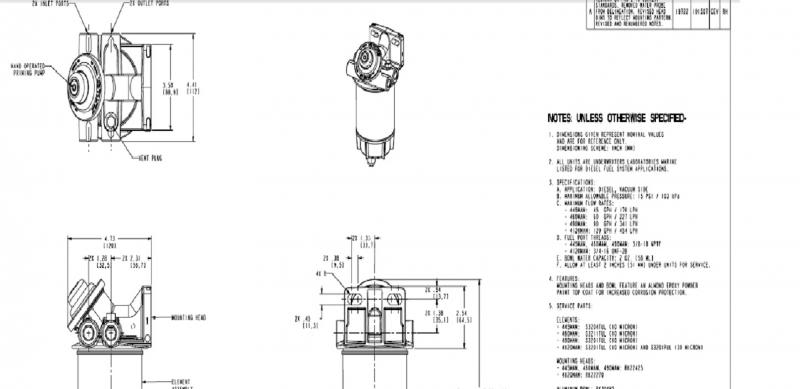RickB
Guru
- Joined
- Oct 20, 2007
- Messages
- 3,804
- Vessel Make
- CHB 48 Zodiac YL 4.2
... maybe it's a fuel-flow sensor.
Maybe it's a scuttling charge.
... maybe it's a fuel-flow sensor.
Maybe it's a scuttling charge.



Shouldn't fuel pumps usually pull/suck fuel from filters rather than pushing fuel through them.
Looking at the port side, it looks like there are 2 #5 plungers, unlike the single plunger on the stbd side. Yes, Per, it is spring loaded and pushes in and out but it doesn't seem to vent.
Here's an engineering drawing that shows a vent plug like RickB described on the top view of the filter housing. I don't see that vent in the photos. Will have to look closer on the boat.
btw, those filters are marked 01-09-06; perhaps time to replace those?
Good question. When I changed the filters, I filled them with diesel fuel, then spun them on.
Howdy FlyWright.... Not to add confusion while you are working through other issues....But when I read that you pre-filled the fuel filters, I thought I'd offer this advice as I've been called a little anal about this kind of thing by my pals... I also pre-fill my fuel filters especially the ones on my larger engines that hold close to a gallon of diesel, to shorten the priming time. However, I have a pipe nipple for each size filter hub that I have to do maintenance on around here (bus, tractors, generators, boat, truck, etc). When threaded into the filter, it allows me to pour unfiltered diesel into the shell side of the filter only, ensuring any fuel getting to my injector pump is filtered at 2mic. You may already do something like this but just didn't mention it in your post....Just something to think about..Good luck with your fuel project!
Good question. When I changed the filters, I filled them with diesel fuel, then spun them on.Howdy FlyWright.... Not to add confusion while you are working through other issues....But when I read that you pre-filled the fuel filters, I thought I'd offer this advice as I've been called a little anal about this kind of thing by my pals... I also pre-fill my fuel filters especially the ones on my larger engines that hold close to a gallon of diesel, to shorten the priming time. However, I have a pipe nipple for each size filter hub that I have to do maintenance on around here (bus, tractors, generators, boat, truck, etc). When threaded into the filter, it allows me to pour unfiltered diesel into the shell side of the filter only, ensuring any fuel getting to my injector pump is filtered at 2mic. You may already do something like this but just didn't mention it in your post....Just something to think about..Good luck with your fuel project!
Probably talking primary filters which it's OK to fill from a clean container...but you are right to only pump prime all the way through the secondary (usually engine mounted) filter.
R I doubt the Walbro has more than 10 hrs on it, but it is dead

I woke up early this morning and read the thread. It was nice living vicariously through the whole ordeal and not doing my boat work.
Al, glad you worked it out and on a mooring as well. So tell me about the double moorings. Catalina has double moorings with a single ball. There is a wand you pick up that has a line attached to the bow mooring line. You pull that onto your bow cleat and there is a second line called the sand line. It goes to the rear mooring line. You walk that line down the side of your boat to the stern where you can pull up the stern line and cleat it off. It's very easy as long as you have the boat lined up with both mooring blocks below the boat.
As to fuel pumps, electric pumps push very well but don't suck well at all. Mechanical pumps suck very well and don't push that well. That's why the electric fuel pumps are located near your tank and the mechanical on your engine. In your car, electrics are internal to your tank.
I only let it run for a couple seconds since I wasn't planning to purge/vent the filters and didn't want to over-pressurize anything.
Clean fuel polished 24/7/365 does not mean a clean fuel tank.
Its the tank that sloughs off gunk to clog filters.
 Since that mess occurred, I try to never go to anything but well used and well serviced fuel docks.
Since that mess occurred, I try to never go to anything but well used and well serviced fuel docks.


I replaced my mechanical pump on my truck and the GM Diesel forum administrator who is also a professor in mechanical engineering stated those facts. I didn't pull them out of my arse.

Clean fuel polished 24/7/365 does not mean a clean fuel tank.
Its the tank that sloughs off gunk to clog filters.

